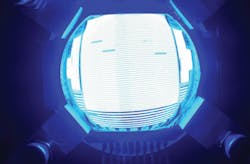Wafer-level LED chip emits 157 W of optical power, could potentially emit tens of kilowatts
Chinese researchers from the Suzhou Institute of Nano-tech and Nano-bionics (Suzhou), Chinese Academy of Sciences (Beijing, Xiangneng HuaLei Optoelectronic Co. (Chenzhou) and several universities in China have created a gallium nitride (GaN)-based wafer-level LED (WL-LED) chip that produces 157 W of blue light from an emitting region approximately 30 mm in diameter.1 (As with standard blue-emitting LEDs, the use of a yellow YAG phosphor can then be used to turn the emitter into a white-light LED for general illumination.)
The external quantum efficiency of the device is 24% at a driving current of 4 A. The group expects that much larger chips will be developed over the next decade, up to the size of entire 8-in,-diameter wafers, leading to light outputs in the tens of kilowatts.
Central lighting
The ultimate goal of the research is to explore the idea of a centralized light-supply system in which a building, or even an area of a town, is lit by distributing light from a very high-power central source, analogous to central heating systems or the distribution of electrical power. The idea is to exploit efficiencies of scale in the generation of light at the central source.
Such a system would require low-loss fiber-optic or other light-pipe distribution technologies to duct and distribute light from the high-power central light source, but the researchers say this is a new way to light buildings and regions.
Single-chip assembly
In the single-chip resistance-matching assembly approach used by the researchers, integrated circuits are created on a wafer substrate as normal, but are then assembled (LEDs and auxiliary electronics) without being separated from the wafer. The approach allows the creation of LED chips with areas a hundred times larger than the highest-power LED chips previously produced (which emit about 10 W of light).
Such large chip areas normally incur an exponential drop-off in the yield achievable; avoiding this is the key advance of the research. It required a combination of other smaller advances, as team leader Yong Cai explains. “We developed several technologies, including series and parallel network designs, resistor matching, and active liquid heat dissipation and plug-in electrodes, to successfully fabricate this chip," he says.
Their series and parallel network design is capable of controlling the yield drop-off even for a chip area covering a whole 2-in. diameter wafer; the active liquid cooling system they developed keeps the junction temperature below 100°C, even with a 1 kW input power.
In addition to boosting the optical output by enlarging the wafer size, the researchers will further increase output by using rough surfaces with high light extraction efficiency (LEE), and also use the waste heat to heat buildings.
Aiming for 30% WPE
The preliminary experimental results show a wall-plug efficiency (WPE) of about 15% at a 1 kW electrical input. "It is expected that when WPE reaches greater than 30%, WL-LEDs could be applied in real very high-power luminaires," says Cai. "Analyzing our results, it was found that the uniformities both of epi-wafer and chip process are the key factors impacting WPE."
REFERENCE:
1. Yibin Zhang et al., Electronics Letters, 4 December, 2014; doi: 10.1049/el.2014.3657
About the Author
John Wallace
Senior Technical Editor (1998-2022)
John Wallace was with Laser Focus World for nearly 25 years, retiring in late June 2022. He obtained a bachelor's degree in mechanical engineering and physics at Rutgers University and a master's in optical engineering at the University of Rochester. Before becoming an editor, John worked as an engineer at RCA, Exxon, Eastman Kodak, and GCA Corporation.

